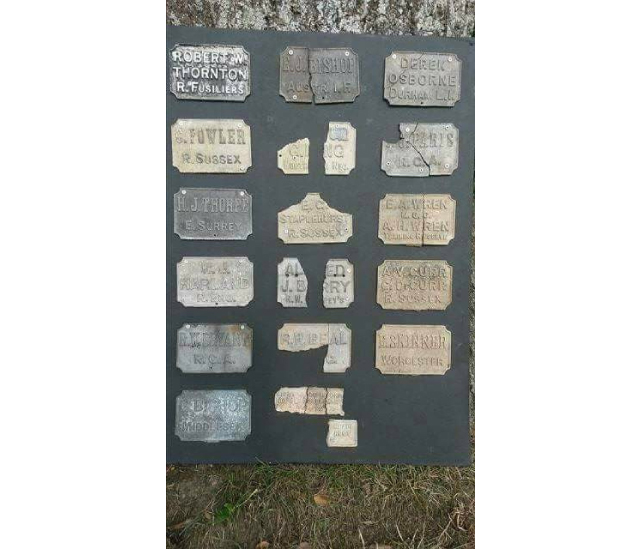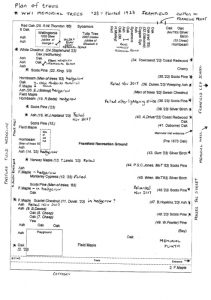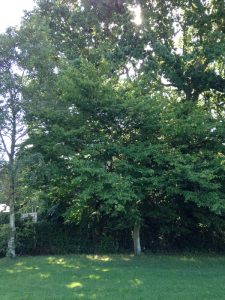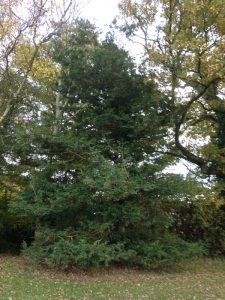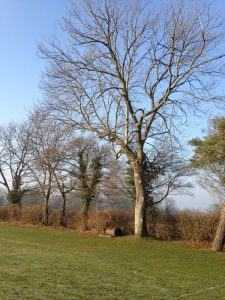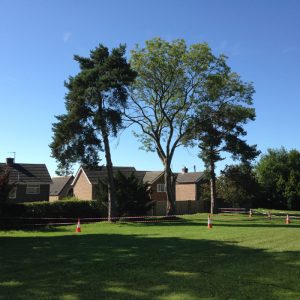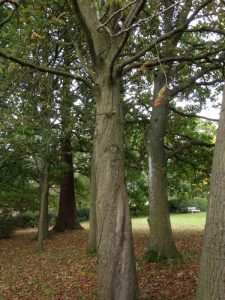After the First World War, the village of Framfield, East Sussex planted trees to commemorate its fallen soldiers.
In 1918, the Government found that it had amassed £6m from sales in military canteens so allocated £1.5m to a Welfare Fund for the benefit of returning soldiers. This worked out to be an award of 5 shillings (25p) per returnee – the average weekly wage in 1918 being 30 shillings.
180 lucky Framfield soldiers returned and, after financial adjustments, £45 from the fund was granted, to be managed by soldiers and a local committee rather than individual donations. The committee decided they wanted to use the money to try and create a Recreation Ground – a park of peace far removed from the horrors of the Western Front.
A field behind the local school was thought to be ideal and the landowner, Mrs. Curteis, agreed to sell it to them for £385. The tenant farmer, Mr. Pratt, although having already planted the field, agreed to waive his rights for £5 compensation. Nevertheless they had to find more funds to complete the purchase so local fundraising began and £60 was raised. However, when they approached Mr. and Mrs. Eaton, of Thurston Hall, the couple said that they wished to pay the full amount in memory of the fallen of the Parish.
These hugely charitable and generous parishioners made no stipulation on their gift expressing only that all religions would be free to use the recreation ground, but Mr. Eaton hoped that no ‘conchy’ would ever step foot on it. In July 1921 it was duly opened.
In 1923, 60 trees of 20 varieties were planted around the perimeter of the ground each bearing a plaque at the foot of each trunk inscribed with the name of a soldier and his regiment.
Some of these soldiers commemorated were:
Lieutenant John de Carrick Cheape:
John de Carrick Cheape was born in Switzerland in January 1894 and lived with his mother Antoinette at Great Streele Farm, Framfield. From 1909-1913 he was at Clifton College and at war’s outbreak was studying at Cambridge University.
John enlisted immediately, joining the 8th Royal Sussex as a Private in September 1914. Having served in the Officer Training Corps at Clifton and Cambridge, he was soon promoted to Corporal and then recommended for a Commission. 2nd Lieutenant Cheape stayed with 8th Royal Sussex, who were tasked as Pioneers in 18th (Eastern) Division, and deployed to the Albert area of France with them in July 1915.
He was soon promoted to Lieutenant. Hard pioneering work in winter 1915-16 afflicted Lt Cheape, and he was hospitalised in Rouen and in the UK between Feb-June 1916. He returned to the Western Front in July, drafted to D Company, 13th Royal Sussex, who had been greatly depleted at the Battle of Boar’s Head. With his pioneer experience he soon became Field Works Officer. On 3rd September 1916, 13th Royal Sussex supported their sister battalion, 11th Royal Sussex’s attack on Beaucourt Ridge as part of the Battle of the Somme. Casualties were heavy and John took over and led A Company when their officer fell. At the end of the action Lt Cheape went out to recover the wounded with a stretcher party.
In so doing, he was shot and killed by an enemy sniper. Lieutenant Cheape is buried at Hamel Military Cemetery, Beaumont-Hamel, France.
Private Ambrose Driver:
Ambrose Driver was born in Framfield in autumn 1885, third child of Thomas, an agricultural labourer, and Ellen Driver. Ambrose lived with his family at Hawkhurst Gate, Blackboys.
By 1911 Ambrose worked as a farm labourer for Edward Brooker at Palehouse Farm in Framfield, and was still working there when war broke out. Ambrose was one of the first local men to join the 1st Southdown Battalion, in Lewes in early September 1914.
With his battalion, now embodied as the 11th Royal Sussex, Ambrose deployed to the Western Front in March 1916. April saw them in the trenches at Givenchy and conduct their first trench raid, and in May they performed fatigues for the Royal Engineers and served in the trenches at Festubert, where Framfield resident and war-poet 2nd Lt. Edmund Blunden joined them.
In preparation for the upcoming Somme Offensive, 116th Brigade was tasked with a diversionary ‘holding action’ in the Richebourg area to prevent the Germans from sending reinforcements south to the Somme. 12th and 13th Royal Sussex were tasked to assault the German salient known as the ‘Boar’s Head’, with the 11th Battalion providing support. They all went ‘over-the-top’ at 3.05am on 30th June 1916, but the Germans expected the attack, which proved a massacre.
Over 1,100 men of 116th Brigade became casualties on the 30th June, 15 officers and 364 Other Ranks were killed or died from wounds. Ambrose was one of the wounded. He was first treated by 132nd Field Ambulance RAMC and then moved likely to 33rd Casualty Clearing Station RAMC in Bethune, where he succumbed to his injuries the following day. Ambrose was buried in what became the Bethune Town Cemetery.
Acting/Farrier Sergeant William John Harland:
William was born in spring 1872, eldest son to Sylvanus and Harriet Harland of Blackboys Lane. He started work as an agricultural labourer, but by 1897 was employed in a Denmark Hill veterinary institute as a blacksmith. In September 1899 he married Alice Relf in Lewes and moved to the Isle of White, five of his children being born there.
By the outbreak of war the family were in St Leonard’s, and William volunteered in November 1914, albeit it overage and under-height: the Army needed skilled blacksmiths. His family moved to Jubilee Cottage, Blackboys. William was assigned to the 22nd Division Signals Company, Royal Engineers, at Seaford, and deployed to Flesselles, France in September 1915. The 22nd Division was then immediately moved to the new Salonika Front.
In October 1916 William was promoted to Acting Farrier Sergeant, but was suffering acutely from sciatica. Salonika was a quiet front due to political expediency, but in April 1917 the British attacked in the Lake Dorian sector, 22nd Division being involved. The Salonika front became more renowned, due to its climate and conditions, for the casualties caused by malaria, dysentery and other such diseases. More men died from these there than in combat.
On the 28th November 1917 William was admitted to 28th General Hospital, having contracted malaria. He died there on 1st December 1917. William is buried at Salonika (Lembet Road) Military Cemetery, Greece.
Sergeant Herbert Hopkins:
Herbert Hopkins was born in Framfield in Spring 1893, the fourth of eight children born to James, a farm steward, and Emily Hopkins, of Newlands, High Cross, Framfield. By 1911, Herbert worked as a gardener on the High Cross estate of the Thornton family.
By the outbreak of war, however, Herbert was in Welshpool, North Wales, and on the 28th August 1914, he enlisted in the local 7th Battalion Royal Welsh Fusiliers (7th RWF). Herbert signed on for overseas service in September and in August 1915, newly promoted to Lance Corporal, he and 7th RWF were deployed to Suvla Bay as part of the Gallipoli expedition. The 53rd Division attack on Anafarta Ridge was a shambles and 7th RWF suffer heavily from casualties and disease throughout the campaign.
By November 1915, Herbert was a Sergeant. In December 1915, 53rd Div were withdrawn to Egypt. In January 1917, 7th RWF were part of the ‘Desert Column’ invading Turkish Sinai & Palestine. The first major battle was at Gaza on 26th March and 7th RWF were tasked to take the strategic 300′ knoll to the southeast of the city. 1,500 yards of the 7th RWF’s advance was in full view of the Turks and they were hit with artillery and machine gun fire.
They only got to within 500yds of the Turkish positions before forced to withdraw. Herbert was killed in the assault and his body sadly not recovered. With no known grave, Herbert is remembered to this day on the Jerusalem Memorial.
Private Ernest George Staplehurst:
Ernest was born in Laughton to Henry and Ruth Staplehurst in early 1888, and he spent his youth at Peckham Farm in Framfield. By 1911 Ernest was a cowman in Palehouse Common, living with his widowed mother.
Ernest joined the 1st Southdown Battalion, alongside other Parish men and his brother Fred, in Lewes in September 1914 and, as the 11th (1st Southdown) Battalion Royal Sussex, went to the Western Front with them in March 1916. He participated in his first attack, at Beaucourt Ridge, Somme, on 3rd September, and at the notorious Schwaben Redoubt and ‘Stuff Trench’ in the October. 11th Sussex moved up to Ypres and on 31st July attacked at Pilkem Ridge to commence the 3rd Battle of Ypres (“Passchendaele”).
Ernest was severely wounded here, and on recovery was posted to the 7th Royal Sussex. By September 1918, 7th Royal Sussex, with Ernest, were engaging the German Army on their Hindenburg Line, as part of the ‘Hundred Days to Victory‘. On the misty dawn of 18th September 1918, 7th Royal Sussex, led by Ernest’s A Company, attacked the German Alpine Korps positions south of the fortress village of Epehy. As 35th Brigade failed to secure Epehy itself, 7th Sussex came under machine gun fire from German positions on their exposed right flank as they advanced towards Malassise Farm.
Ernest was one of those wounded. Although evacuated to a Casualty Clearing Station, he succumbed to his wounds and was buried in what became Doingt Communal Cemetery Extension near Peronne.
In 1935, The Royal British Legion offered to help with the management of the trees and in that same year a Wellingtonia tree was planted to commemorate the Silver Jubilee of King George V.
The ground was acquired for war use in WW2 and rented to the Observer Corps for the princely sum of £1 a year. Many locals still remember trenches being dug on it and the Home Guard using it for training. Framfield was in ‘bomb alley’ and suffered many V1 ‘doodlebug’ hits and plane crashes and at one point 5 German airmen were buried in the local church cemetery to be later exhumed and re-interred in Germany after hostilities.
By 1945 the ground was pretty churned up but was flattened out for public use again by farmers’ rollers and in the late 1950s responsibility and ownership was transferred to the Parish Council.
The recreation ground was the site for a returning Framfield resident and hero, the transpolar explorer, Charlie Burton who, with Ranulph Fiennes, had completed a 3 year trek from pole to pole. When Charlie Burton came back to the village in 1982, he posed for photos and signed autographs but added that he wanted to escape from the memories of the freezing ice floes and biting polar winds and how glad he was to be able to return to the peace, green fields and tranquility of Framfield.
When our 180 men came back from the horror of WW1 they wanted the same – a place to spiritually unwind, reflect and, with the passing of the years, appreciate the calm and peaceful motion of the surrounding trees planted in remembrance of the fallen.
They were the lucky ones. 700,000 men from across the country were not so lucky.
We are today’s lucky ones because of those young men from Framfield and their dream of a peaceful remembrance park.
This was their gift to the future.
This story and all its images were submitted by Lisa Moore. It includes information from Paul Leader (Ref-Framfield & Blackboys Through the Ages by MI Green & PM Allsop – September 2016 ). Research and individual soldier’s stories were compiled by Jim Hastings and photos were contributed by Sam Weddell.

